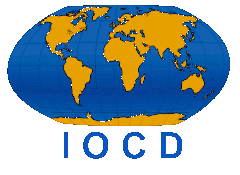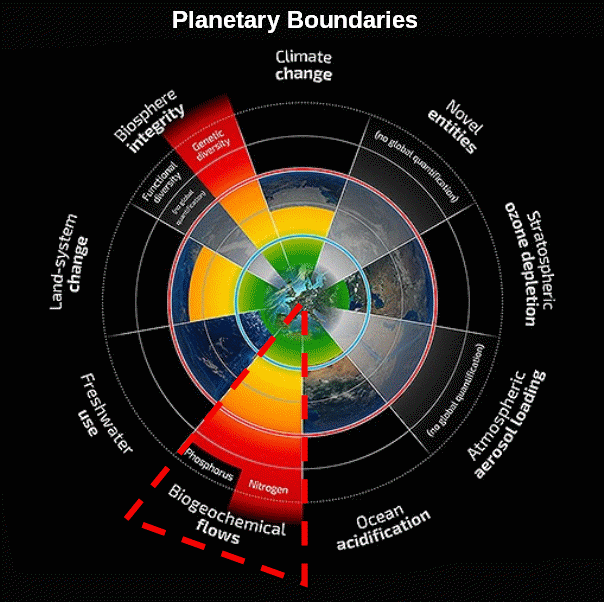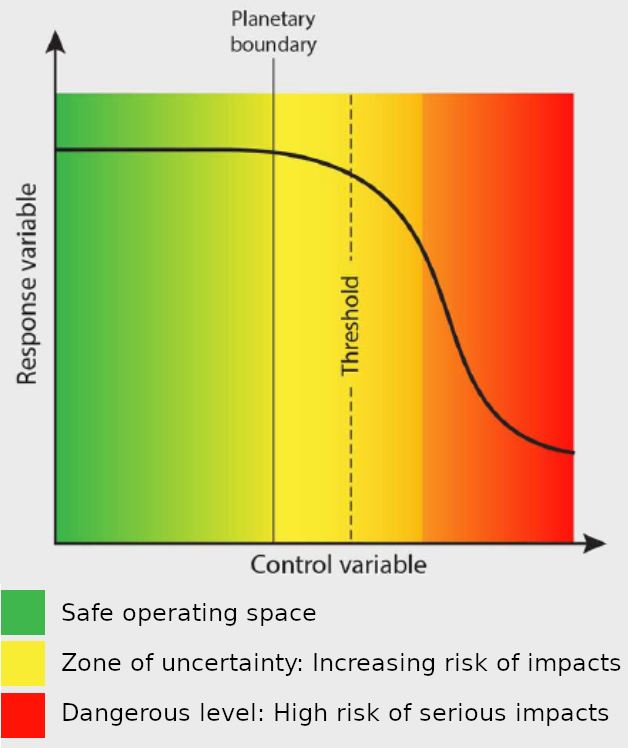⇑ One-World Chemistry
Sustainable Development
The Concept of Sustainable Development
| 1972 | The Club of Rome published a highly influential report entitled The limits to Growth [1], which predicted the disastrous impacts that would follow from exponential economic and population growth in a world of finite resources. |
|---|
| 1987 | The World Commission on Environment and Development chaired by former Norwegian Prime Minister Gro Harlem Brundtland produced a report [2] which defined sustainable development as “development that meets the needs of the present without compromising the ability of future generations to meet their own needs”. |
|---|
| 1992 | The UN Conference on Environment and Development (Rio: 'Earth Summit') issued the Earth Charter (Agenda 21): building of a just, sustainable, and peaceful global society in 21st Century [3], which aimed towards "socially inclusive and environmentally sustainable economic growth". |
|---|
| 2012 | The UN Conference on Sustainable Development (Johannesburg: 'Rio+20') issued an outcome document, "The Future We Want" [4], with 192 governments renewing their political commitment to sustainable development. |
|---|
| 2009- 2015 | The concept of planetary boundaries was developed and refined, with nine boundaries being identified and partly quantified [5,6]. This proved very influential in the formulation of the UN Sustainable Development Goals. |
|---|
| 2015 | United Nations Agenda 2030: 17 Sustainable Development Goals were adopted by all 193 Member States [7]. |
|---|
- For a list of the 17 UN Sustainable Development Goals and chemistry's role in achieving them, click here.
Planetary Boundaries
The concept of Planetary Boundaries has been developed by the environmental scientist Johan Rockström in Sweden, the chemist Will Steffen at the Australian National University, and others [8]. They have identified nine Earth system processes which have boundaries and have used these to defining a "safe operating space for humanity".
Three of the boundaries concern biogeochemical flows of key elements that are relatively abundant in either the Earth's crust (carbon: 0.18%; phosphorus: 0.1%) or atmosphere (nitrogen: 0.002% in the crust and 78% of the atmosphere). In each case, there is a problem because industrial uses are contributing to major environmental changes. For example, combustion of carbon-rich materials to produce energy is generating greenhouse gases that are causing climate change; the atmosphere and water resources are suffering pollution by nitrogen oxides and nitrates that come from the production of nitrate fertilizers; and water bodies are also being polluted by phosphate fertilizers.
In the case of nitrogen, It is estimated that the planetary boundary for the introduction of new ‘reactive’ nitrogen to the Earth system is 62-82 Tg N per year, while the current scale of production is far in excess of this, at about 150 Tg N per year.
21st Century Challenges
A number of factors at play in the world are acting together to create multiple challenges. These include:
- A growing population: From about 1 billion people on the Earth in 1800, the planet's population expanded to about 6 billion in 2000 and to more than 7 billion now. It is predicted to grow to at least 9 billion by 2050 and around 11 billion by 2100. This is creating increasing demands for resources of every kind, from water and food to energy and materials for clothing, shelter, transport, work and leisure.
- Growing urbanization: In 1950, about 30% of the world's population lived in urban areas. This proportion has now increased to over 50% and it is predicted that by 2050 two thirds of the world's population will be urban. Currently around one in eight people live in the world's 28 mega-cities with more than 10 million inhabitants; but by 2030, the world is projected to have 41 of these mega-cities. As the world continues to urbanize, sustainable development challenges will be increasingly concentrated in cities, particularly in the lower-middle-income countries where the pace of urbanization is fastest. Integrated policies to improve thelives of both urban and rural dwellers are needed [9] - and systems thinking about how chemistry and other sciences can ensure that these environments are healthy and sustainable.
- Shortages of materials: The planet's resources are increasingly under strain and many critical resources are already either in short supply or will become so in the coming decades. Examples include:
- Water: The Earth is a water rich planet, and annual human and animal consumption is much less than 1% of the world's total water supply. But clean, affordable water that is fit for human beings to drink is in short supply on our planet. Population growth and economic development are driving a steadily increasing demand for new water supplies, and global demand for water has more than tripled over the past half century. Globally, the largest user of fresh water is agriculture, accounting for roughly three quarters of total use. In Africa this fraction approaches 90%. In the USA, agriculture accounts for 39% of fresh water use, the same as the fraction used for cooling thermal power plants. Future prospects are not encouraging. Global water withdrawal in 2000 was estimated to be 1,000 cubic miles (4,000 km3), about 30% of the world's total accessible fresh water supply. By 2025 that fraction may reach 70%. Over-pumping of ground water by the world's farmers already exceeds natural replenishment by more than 160 km3, 4% of total withdrawals. WHO estimates that, globally, 1.1 billion people lack access to clean water supplies and that 2.4 billion lack access to basic sanitation. 1,000 m3 is the per capita annual amount of water deemed necessary to satisfy basic human needs. In 1995 166 million people in 18 countries lived below that level. By 2050 potable water availability is projected to fall below that level for 1.7 billion people in 39 countries. Water shortages now plague almost every country in North Africa and the Middle East [10].
- Energy: Overall, there is no present shortage of energy in the world, since there are massive reserves of fossil fuels like coal, oil and natural gas in the ground. But continuing to extract and burn these reserves as the main means of generating energy is not sustainable. Sooner or later, these reserves would be exhausted; and meanwhile their combustion would continue to contribute massive amounts of greenhouse gases to the atmosphere, with severely damaging consequences for climate change. So, there is a shortage of clean, sustainable energy generation worldwide.
- Endangered elements: Of the 118 elements that make up everything on the planet, about 44 will face supply limitations in the coming years. These critical elements include rare earth elements, precious metals, and even life-essential elements like phosphorus. Research into more abundant alternatives, more efficient uses, recycling and recovery will help mitigate risks and move industry towards sustainable supply chains [11].
- Food: In the 20th century, agricultural production was able to more than keep pace with the rapidly expanding global population – although the highly uneven access to food in different places meant that many people still starved. The combined pressures of population growth, climate change and water shortages mean that it will be increasingly difficult for agricultural output to continue growing at a sufficient pace to avoid malnutrition and starvation in many parts of the world.
- Emerging and re-emerging infectious diseases: The appearance and re-appearance of diseases like TB, HIV/AIDS, Ebola and Zika, combined with the growing resistance to anti-microbial agents that has spread to every part of the world, presents severe challenges to health globally [12].
- Environmental pressures: Our physical environment (the air, land and water on the surface of the planet) and our biological environment (including all the flora and fauna that live in the physical environment) form a complex, interactive ecosystem that is increasingly subjected to pressures of many kinds, including:
- Increasing pollution: Pollutants from human activities &ndsh; industry, agriculture, sewage and waste water disposal, energy production, transport, etc.
- Deforestation: Destruction of forests in order to make way for agriculture, mining and human settlements is continuously eroding this vital natural resource, which is a repository of valuable natural products as well as a major factor in the capture of carbon dioxide from the atmosphere.
- Contamination with pharmaceuticals: Pharmacy products for both human and veterinary use find their way into the environment and get taken up by diverse species of organisms, damaging them and in some cases entering the food chain that ends with consumption by people.



